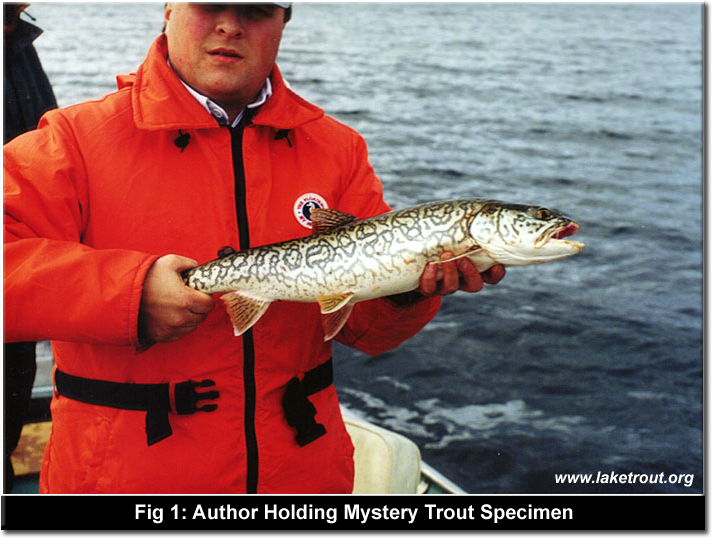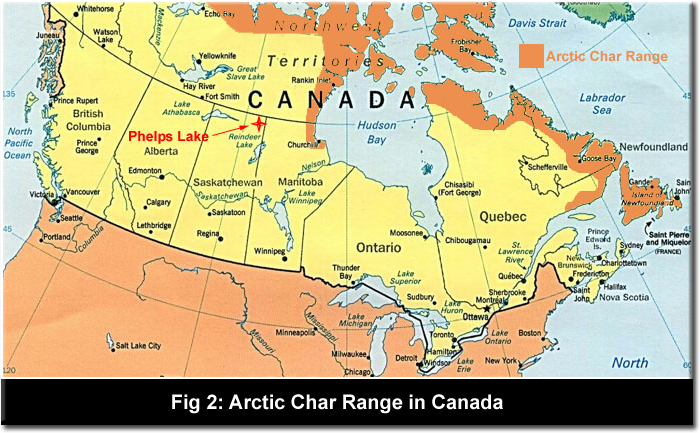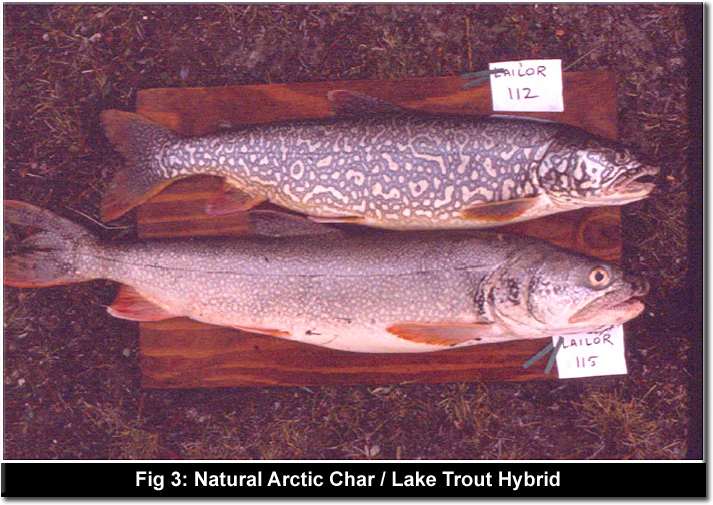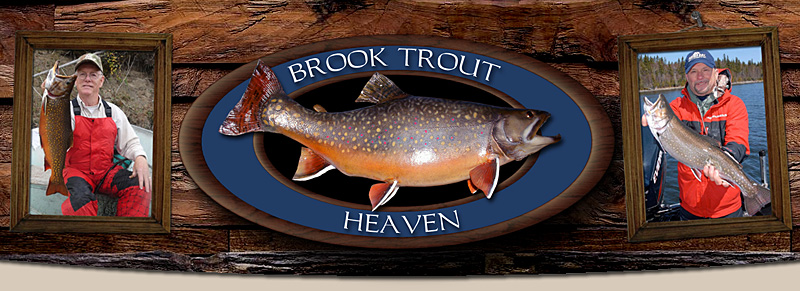Is it a Tiger Trout?
 The Mystery Trout of Phelps Lake, Saskatchewan
The Mystery Trout of Phelps Lake, Saskatchewan
By: Brent A P Osika, Wolf Bay Lodge
Toll Free: 1-866-220-1346
www.wolfbaylodge.ca
Located on the edge of the Canadian Shield in northeastern Saskatchewan is Phelps Lake, a glacier formed 32 mile long body of water known for its unique structure. Rock outcroppings and sand eskers adorn the Lake's awe-inspiring scenery; it is dappled by countless islands and supported by numerous tributaries. Phelps Lake provides superb habitat for the fish residents, and on the surface appears to be just another northern lake. But what lies beneath the surface is where the mystery begins.
Phelps Lake's remote location has allowed it to escape the modern day invasion of the prospectors and the square hook fisherman. Having never been commercially or recreationally fished, Phelps Lake has just recently opened up to angling and the outfitting industry in the late-1990s. When anglers first cast their lures upon its surface and broke the water, they found a healthy and vigorous fishery teaming with world-class trophy fish. Schools of Lunker lake trout were found inhabiting the depths, predatory northern pike defending the shallows, and grayling, whitefish and suckers patrolling the incoming waters. All appeared normal for a lake of its size until one fish was raised from the depths that did not look normal.
 This fish which adopted the name 'The Mystery Trout' first appeared in 1995 and has since appeared three more times in the following years. In practice with current conservation, all four fish were released back into the waters from which they came. While its true identity has eluded us so far, all four fish caught to date have been about the same size and have looked similar in their shape and skin patterns. As they have been caught at different parts of the lake and years apart, it begs to differ that these are not the same fish, but multiple fish of a different nature.
This fish which adopted the name 'The Mystery Trout' first appeared in 1995 and has since appeared three more times in the following years. In practice with current conservation, all four fish were released back into the waters from which they came. While its true identity has eluded us so far, all four fish caught to date have been about the same size and have looked similar in their shape and skin patterns. As they have been caught at different parts of the lake and years apart, it begs to differ that these are not the same fish, but multiple fish of a different nature.
Once photos of this oddity circulated the wider fishing community, many theories were posed by leading experts around the continent as to the species and origin of this rarity.
Dr.Robert Behnke from Colorado State University, one of the top men in the U.S. for Salmonid identification, was puzzled at first, but finally hauled down an old book printed in Great Britain and found some paintings that looked very much like The Mystery Trout. The one that looked the most like it, in terms of markings, was a hybrid between a char and brown trout.
Dr. E. J. Crossman, Curator Emeritus from The Centre for Biodiversity and Conservation Biology at Royal Ontario Museum theorized the pattern is slightly reminiscent of a tiger trout, a Brook trout X Brown trout hybrid.
Steven J. Herrington from the Department of Fisheries Auburn University in Alabama believes the evidence points to The Mystery Trout as being a genetic mutant, or color variant, of the Lake Trout.
Others experts have suggested that it may be an Arctic Char / Lake Trout hybrid or again a Brown Trout / Brook Trout hybrid (commonly called a Tiger Trout). However, the Tiger Trout is strictly a hatchery fish that does not occur naturally, there has never been stocking programs of Tiger Trout anywhere near the Phelps Lake area, and Brown or Brook Trout do not inhabit the area. What is known though by the fishes shape and features is that they originate from within the Salmonid family of fish.
Lake Trout and Arctic Grayling are the only Salmonids (besides whitefishes) collected in Phelps Lake. It is doubtful that it's a mix between the latter two due to their different spawning times and habits, Lake Trout in the fall at night and Grayling in the spring during daylight. Plus the general appearance and lack of any reports describing hybridization of the two do not support the theory either.
 Salmonids (trout, salmon and whitefish) are genetically a "plastic" fish, meaning that they can exhibit a wide variation of different color patterns, shapes, feeding, and habitat preferences within a species. The Lake Trout exhibit this genetic "plasticity" with widely differing colors and shapes, as seen in Phelps Lake. They are noted for being among the most "plastic" of the chars, with several strains having distinct markings identified from the Great Lakes and elsewhere. An example of this is the Siscowet from Lake Superior, or the Aurora Trout from southern Ontario.
Salmonids (trout, salmon and whitefish) are genetically a "plastic" fish, meaning that they can exhibit a wide variation of different color patterns, shapes, feeding, and habitat preferences within a species. The Lake Trout exhibit this genetic "plasticity" with widely differing colors and shapes, as seen in Phelps Lake. They are noted for being among the most "plastic" of the chars, with several strains having distinct markings identified from the Great Lakes and elsewhere. An example of this is the Siscowet from Lake Superior, or the Aurora Trout from southern Ontario.
Although these are considered to be subspecies of Trout, there are many other different genetic mutants (color variants) that are not subspecies but merely just the byproduct of reproduction. This species exhibit these color variants with some frequency although, on a whole, these variants are generally rare. These mutants occur naturally and are not the byproduct of pollution or the like.
The posed theory of Lake Trout / Arctic Char hybrids is doubtful in this case because Arctic Char are not native to Saskatchewan and no one has collected or angled Arctic Char from Saskatchewan waters, let alone Phelps Lake. This is also a very rare phenomenon between these two species due to their general and reproductive biology. The range of Arctic Char as seen in Figure 2 is still quite far North of Phelps Lake.
However... a researcher with the Fisheries Board of Canada has recently been doing research into these naturally occurring Lake Trout x Arctic Char hybrids within the North West Territories and Nanuvut. He has captured some of these oddities from the northern waters of Canada and says:
"Your mystery fish looks very much like lake trout that I saw across the Arctic, which almost exclusively occurred in lakes where Arctic Char or Lake Trout x Arctic Char hybrids were found. My working hypothesis is that the hybridization event disrupts a developmental gene that controls the formation and expression of melanophores (like pigments) in the skin, thereby altering the final colour phenotype (skin characteristic). The possibilities are interesting, and your fish are probably the southernmost limit of these morphs, if this is the case"
As can be seen from figures 3 and 4, the natural hybrid caught in the far north (figure 4 #112) has similar markings to the Mystery Trout of Phelps Lake (figure 3), although certain features, like the underlying skin color and fin vermiculations, remain different?
 In the summer of 2004 from the request of the researcher, staff and guests from Wolf Bay Lodge collected adiphose fin samples from 50 Lake Trout from Phelps Lake. Most of the samplings were from 'normal' looking Lakers, but some 'oddities' were sampled also. The samples have been forwarded to the Ontario Forensics Center for further DNA analysis to determine if Arctic Char genes do exist in Saskatchewan waters. If there are Arctic Char genes in Phelps Lake, this would push their range far more South than previously thought.
In the summer of 2004 from the request of the researcher, staff and guests from Wolf Bay Lodge collected adiphose fin samples from 50 Lake Trout from Phelps Lake. Most of the samplings were from 'normal' looking Lakers, but some 'oddities' were sampled also. The samples have been forwarded to the Ontario Forensics Center for further DNA analysis to determine if Arctic Char genes do exist in Saskatchewan waters. If there are Arctic Char genes in Phelps Lake, this would push their range far more South than previously thought.
If there are not Artic Char in the Phelps Lake waters, and these 'morphs' occur naturally and are reproducing and passing the genetics onto the next generation, is it evolving into a subspecies of Lake Trout? At what point in a fish's evolution is it considered to be a subspecies like the Siscowet or Aurora Trout, as compared to just a rare genetic morph?
While these questions still remain and whatever the final findings may be, these Trout are extraordinarily interesting, and are really a prize to have in Phelps Lake! Will the anonymity of the Mystery Trout be solved by DNA analysis, or will the fish's true identity remain anonymous remains to be seen.




 The Mystery Trout of Phelps Lake, Saskatchewan
The Mystery Trout of Phelps Lake, Saskatchewan This fish which adopted the name 'The Mystery Trout' first appeared in 1995 and has since appeared three more times in the following years. In practice with current conservation, all four fish were released back into the waters from which they came. While its true identity has eluded us so far, all four fish caught to date have been about the same size and have looked similar in their shape and skin patterns. As they have been caught at different parts of the lake and years apart, it begs to differ that these are not the same fish, but multiple fish of a different nature.
This fish which adopted the name 'The Mystery Trout' first appeared in 1995 and has since appeared three more times in the following years. In practice with current conservation, all four fish were released back into the waters from which they came. While its true identity has eluded us so far, all four fish caught to date have been about the same size and have looked similar in their shape and skin patterns. As they have been caught at different parts of the lake and years apart, it begs to differ that these are not the same fish, but multiple fish of a different nature.
 Salmonids (trout, salmon and whitefish) are genetically a "plastic" fish, meaning that they can exhibit a wide variation of different color patterns, shapes, feeding, and habitat preferences within a species. The Lake Trout exhibit this genetic "plasticity" with widely differing colors and shapes, as seen in Phelps Lake. They are noted for being among the most "plastic" of the chars, with several strains having distinct markings identified from the Great Lakes and elsewhere. An example of this is the Siscowet from Lake Superior, or the Aurora Trout from southern Ontario.
Salmonids (trout, salmon and whitefish) are genetically a "plastic" fish, meaning that they can exhibit a wide variation of different color patterns, shapes, feeding, and habitat preferences within a species. The Lake Trout exhibit this genetic "plasticity" with widely differing colors and shapes, as seen in Phelps Lake. They are noted for being among the most "plastic" of the chars, with several strains having distinct markings identified from the Great Lakes and elsewhere. An example of this is the Siscowet from Lake Superior, or the Aurora Trout from southern Ontario.
 In the summer of 2004 from the request of the researcher, staff and guests from Wolf Bay Lodge collected adiphose fin samples from 50 Lake Trout from Phelps Lake. Most of the samplings were from 'normal' looking Lakers, but some 'oddities' were sampled also. The samples have been forwarded to the Ontario Forensics Center for further DNA analysis to determine if Arctic Char genes do exist in Saskatchewan waters. If there are Arctic Char genes in Phelps Lake, this would push their range far more South than previously thought.
In the summer of 2004 from the request of the researcher, staff and guests from Wolf Bay Lodge collected adiphose fin samples from 50 Lake Trout from Phelps Lake. Most of the samplings were from 'normal' looking Lakers, but some 'oddities' were sampled also. The samples have been forwarded to the Ontario Forensics Center for further DNA analysis to determine if Arctic Char genes do exist in Saskatchewan waters. If there are Arctic Char genes in Phelps Lake, this would push their range far more South than previously thought.